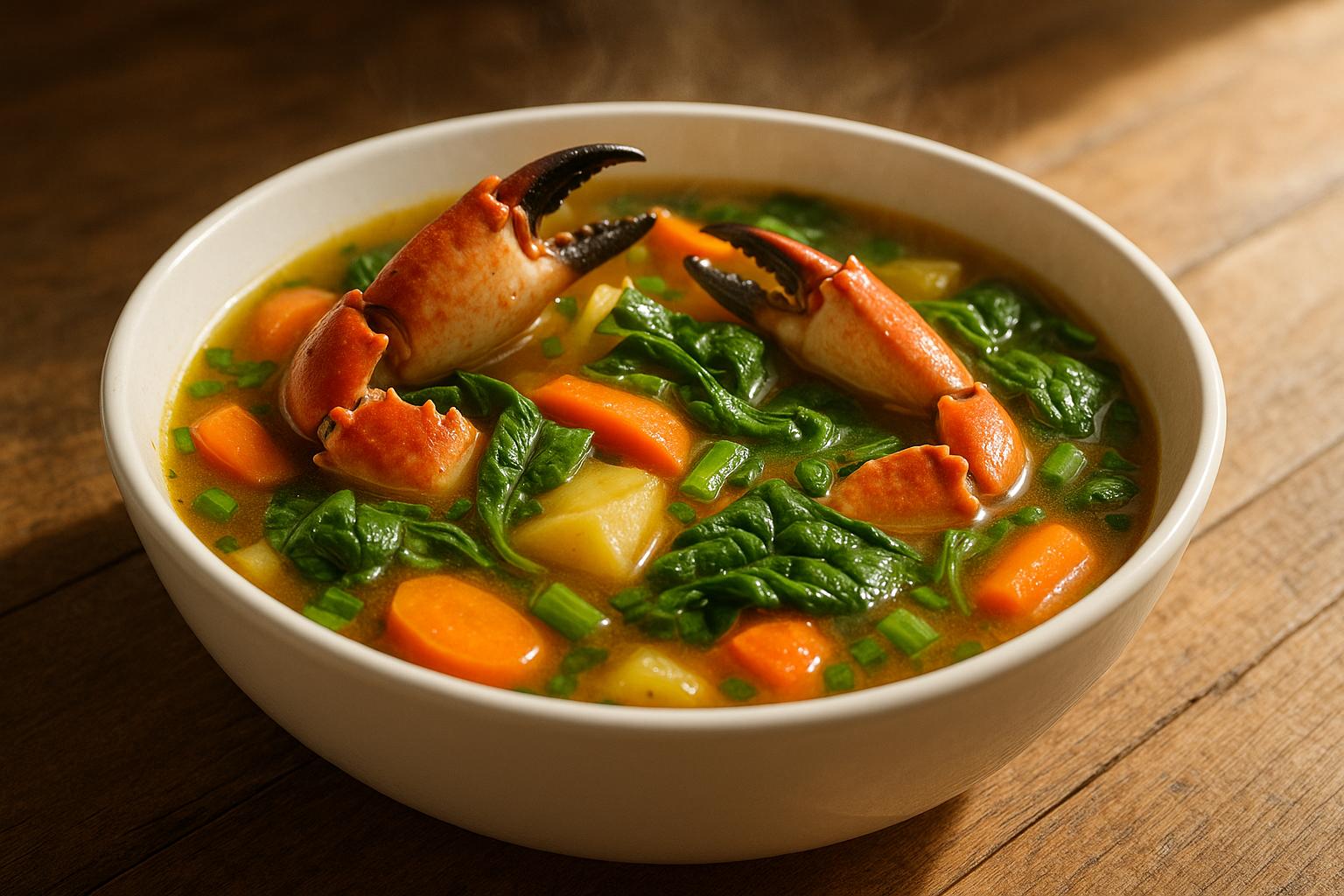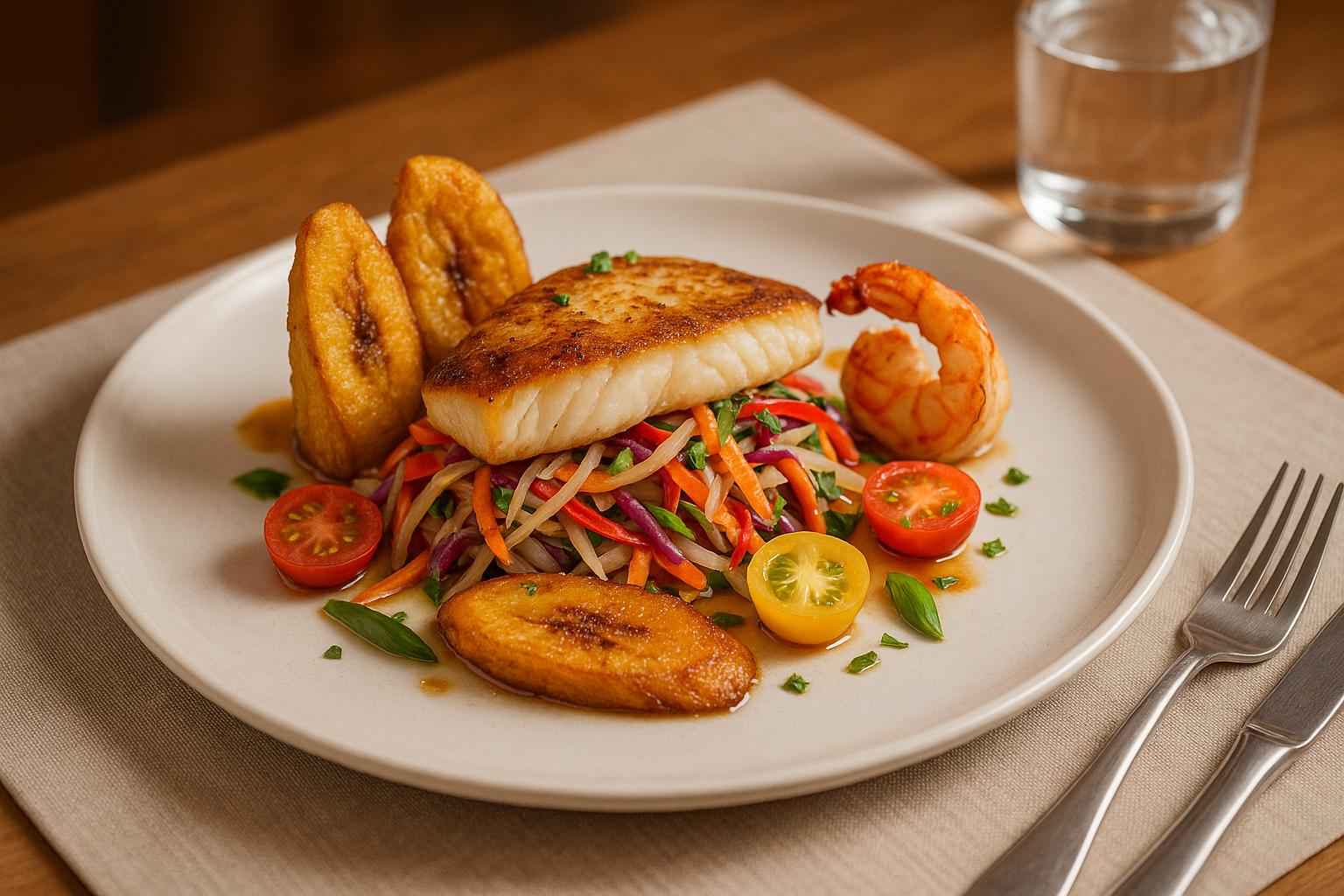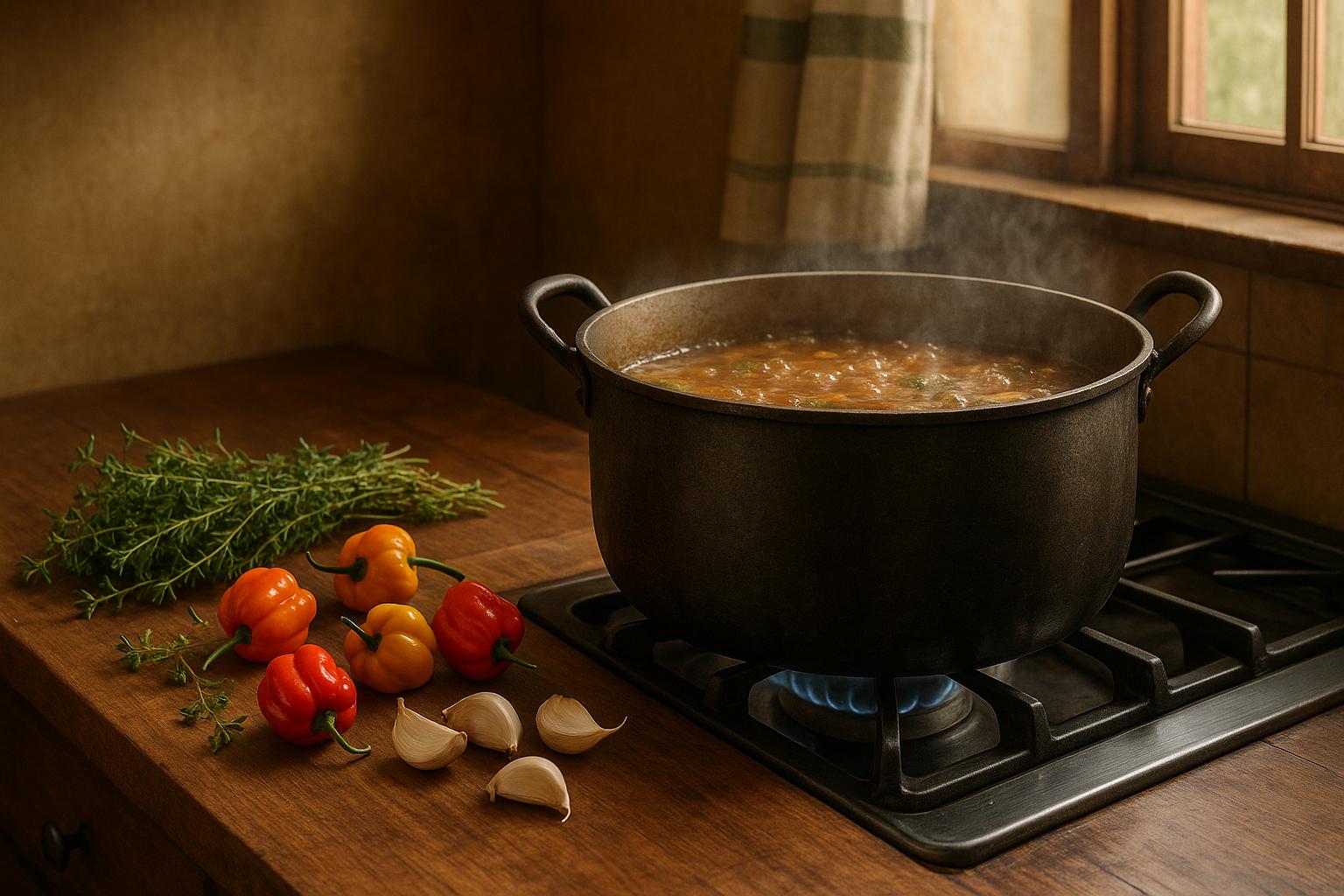Haitian street food is a vibrant mix of flavors, history, and community. It's affordable, packed with bold seasonings like epis, and reflects the daily lives of Haitians. Key dishes include flaky pate, crispy kode, and fried favorites like bannann peze (plantains) and griot (fried pork). Vendors, called "machant", serve meals for as little as $1, making street food accessible to all.
Quick Highlights:
- Pate: Buttery pastries with seasoned meat fillings like beef, codfish, or chicken.
- Kode: Deep-fried turnovers stuffed with cabbage, eggs, or smoked herring.
- Fritay: A collection of fried dishes like plantains, pork, and marinad (spiced fritters), often paired with spicy pikliz.
- Community Role: Vendors provide affordable meals and foster a sense of unity, especially during tough times.
Haitian street food is more than just food - it's a way of life. Whether you're in Haiti or enjoying it abroad, these dishes offer a taste of resilience and tradition.
Haitian Pate Kode -Vegan Pate Recipe (Street foods)
Popular Street Foods in Haiti
Haiti's street food scene is a vibrant showcase of flavors and textures, deeply tied to the country's culinary traditions. These foods reflect the heart of Haitian culture, offering something for every palate.
Pate: Meat-Filled Pastries
Pate is a flaky pastry stuffed with seasoned meat, praised for its buttery, layered crust. Its texture comes from a careful process of kneading and folding the dough with lard or shortening.
Popular fillings include:
- Beef: Seasoned with epis (a flavorful Haitian seasoning blend) and scotch bonnet peppers
- Codfish: A seafood favorite with a salty, savory twist
- Chicken: Infused with local herbs and spices for extra flavor
Kode: Fried Turnovers
Kode are deep-fried turnovers known for their crispy exterior and savory fillings.
"Pate Kode is a Haitian Street delicacy that is easy to make and delicious. Don't underestimate the homemade pastry, it's quite versatile and makes some delicious patties." – Savory Thoughts
Fillings often include combinations like cabbage with spices, hot dogs and eggs, smoked herring with eggs, or chicken with cabbage.
Other Common Street Foods
Beyond pate and kode, Haitian street food offers a variety of dishes collectively called fritay. Each item has its own unique taste and is often paired with traditional accompaniments:
| Street Food | Description | Traditional Accompaniment |
|---|---|---|
| Bannann Peze | Twice-fried green plantains | Pikliz (spicy pickled slaw) |
| Accra | Crispy fritters made from malanga root | Spicy dipping sauce |
| Griot | Marinated fried pork chunks | Pikliz and rice |
| Marinad | Seasoned fried dough | Hot sauce |
These dishes are typically prepared fresh, using traditional methods that enhance their flavors. Together, they represent the rich and enduring heritage of Haitian street food.
History Behind Haitian Street Food
Haitian street food is more than just a quick bite - it reflects centuries of culture, resilience, and tradition. Influenced by African, Caribbean, and French culinary practices, this cuisine serves both practical and social purposes. Its cultural significance is especially evident during festivals, where food plays a key role in bringing people together.
Street Food at Festivals
The practice of Konbit, rooted in West African and Haitian traditions, highlights the communal spirit tied to food. It symbolizes unity and shared purpose. For example, in August 2023, the KAFOUFÈY community organized a Konbit - a communal meal - amid gang unrest to bring people together, especially those displaced from their homes. This tradition echoes the essence of Haitian street food today, which thrives on community and solidarity.
Known locally as "manje kwit", street food vendors are vital in urban areas like Port-au-Prince, offering affordable meals to many. Here's a look at the economics behind it:
| Economic Factor | Impact |
|---|---|
| Average restaurant meal cost | 250 Haitian gourdes ($4) |
| Daily income for many Haitians | Less than $2 |
| Households facing undernourishment | 40% |
Community and Heritage
Haitian street food is deeply rooted in the idea of sharing and community. The saying "MANJE KUIT PA GEN MÈT" (Cooked food does not have any owner) reflects the belief that prepared food belongs to everyone, reinforcing values of generosity and collective support.
Street food vendors often rebuild their businesses quickly after periods of unrest, showing incredible determination. As vendor Cécilia Alfred puts it:
"It is always a pleasure to see your customers trusting you with their bellies"
This tradition is also tied to Haiti's national motto, "L'union Fait La Force" (Unity makes strength). Street food not only connects people but also preserves cultural traditions while providing affordable meals for communities facing tough economic times.
sbb-itb-80c33ff
How to Find and Order Street Food
Discovering Haitian street food is all about knowing what to look for - whether you're in Haiti or at Haitian spots in the U.S.
Finding Good Vendors
Look for vendors with plenty of customers. A busy stall usually means the food is fresh and well-loved. Here’s what to keep in mind:
| What to Look For | Why It’s Important |
|---|---|
| Food turnover rate | Fresh food is always in demand. |
| Cleanliness | A clean setup shows attention to food safety. |
| Classic dishes offered | Staples like pate, griot, and kode point to authenticity. |
| Local currency acceptance | Vendors working with local norms feel more genuine. |
| Customer flow | A steady crowd often signals great food. |
Once you’ve found a trustworthy vendor, placing your order is straightforward.
Basic Ordering Guide
Street food is a key part of Haiti’s lively culture. Be polite when ordering and remember to use cash - gourdes in Haiti or U.S. dollars in Haitian-American spots.
Here are some must-try dishes for an authentic experience:
- Griot: Fried pork, a Haitian classic.
- Tassot: Dried, fried meat with bold flavors.
- Legume: A hearty vegetable stew.
- Pate: Flaky pastries stuffed with meat.
- Kode: Fried turnovers, perfect for a quick bite.
Now, let’s talk about where you can enjoy these dishes in the United States.
Where to Find Haitian Food
The Miami–Fort Lauderdale area, home to a large Haitian community, is a hotspot for authentic Haitian cuisine. For example, Le Jardin Haitian Restaurant in Miami’s Little River neighborhood offers dine-in, delivery, and pickup options.
Here are a few more places to check out:
| Restaurant Name | Location | Highlights |
|---|---|---|
| Cecibon Restaurant | Miami & Fort Lauderdale | Multiple locations serving Haitian–Caribbean favorites. |
| Sak Pase Restaurant | Miami | Known for authentic Haitian street food. |
| Lakay Food Spot | North Miami | Convenient options for dine-in, takeout, and delivery. |
These spots bring the flavors and traditions of Haitian street food to life, right here in the U.S.
Street Food Quick Reference
Here's a quick look at Haiti's beloved street foods, highlighting their key features and ideal times to enjoy them.
Street Food Comparison Table
| Street Food | Description | Main Ingredients | Texture & Style | Best Time to Eat |
|---|---|---|---|---|
| Pate | Savory deep-fried pastry, like a pizza pocket | - Pastry dough - Chicken - Hot dogs - Eggs - Mixed meat fillings |
Crispy outside, warm savory filling | Breakfast or lunch |
| Pate Kode | Crispy turnover with various fillings | - All-purpose flour dough - Cabbage - Bell peppers - Garlic - Parsley |
Flaky, crispy with seasoned filling | Any time |
| Bannann Fri | Fried plantains | - Ripe plantains - Cooking oil - Seasonings |
Crispy exterior, soft interior | Lunch or dinner |
| Marinad | Spiced dough fritters | - Seasoned dough - Mixed spices - Herbs |
Light and crispy | Afternoon snack |
| Lam Veritab Fri | Fried breadfruit | - Fresh breadfruit - Cooking oil - Salt |
Crispy outside, starchy inside | Lunch side dish |
These popular fritay are often paired with pikliz for an extra kick of flavor. Preparation styles vary by vendor, adding a personal touch to each dish. Availability can change daily, with certain items being more common at specific times of the day.
Conclusion
Haitian street food is far more than just affordable meals - it's a lively reflection of the country's cultural roots and the resilience of its communities. This rich culinary tradition continues to influence daily life and inspire creativity in Haitian kitchens.
Key Highlights
Talented street vendors offer meals that are both accessible and deeply rooted in Haitian culinary heritage. Their work reflects generations of expertise, passed down through meticulous preparation and bold, unforgettable flavors.
"Haitian food culture is defined by its bold flavors, resourcefulness, and the intentional use of fresh ingredients. Foundational spices and ingredients include thyme, parsley, cloves, Scotch bonnet peppers, and our signature epis. It's a cuisine that thrives on slow cooking and layering flavors to create depth and balance", says culinary expert Nadege Fleurimond.
Street food has a profound role in Haitian society. A 1983 study found that students in Port‑au‑Prince secondary schools sourced 25% of their calories and 16% of their protein from street foods. Today, these vendors remain crucial for urban food security, each machant adding their personal touch to traditional dishes.
"Haitian food is a labor of love".
This passion shines through every crispy pate, perfectly spiced kode, and tangy serving of pikliz. Whether you're wandering the streets of Port‑au‑Prince or enjoying Haitian cuisine elsewhere, these street foods provide a genuine taste of Haiti's culinary heritage. Dive into this vibrant food culture to experience a living tradition that continues to nourish and inspire communities worldwide.
FAQs
What makes Haitian street food like pate and kode stand out from other street foods around the world?
Haitian street food, including favorites like pate and kode, stands out because of its rich blend of flavors rooted in Haiti's diverse cultural heritage. Influenced by African, French, Spanish, and Caribbean traditions, these dishes combine bold seasonings, fresh ingredients, and unique preparation techniques to create something truly special.
A key feature of Haitian cuisine is epis, a savory blend of herbs, spices, and aromatics that gives many dishes their signature taste. This flavorful base, combined with flaky pastries like pate or the crispy goodness of kode, makes Haitian street food a delicious and unforgettable experience.
What cultural and historical influences have shaped Haitian street food?
Haitian street food is a flavorful reflection of the country's rich cultural and historical heritage. The cuisine blends influences from Africa, France, Spain, and the indigenous Taíno people. For example, the vibrant use of herbs, peppers, and spices has African roots, while French contributions are seen in breads, pastries, and cooking techniques. Spanish colonization introduced sugar plantations, which brought ingredients like okra and taro through the transatlantic slave trade.
Haiti's history, including its fight for independence, has also left a mark on its culinary traditions. A notable example is Soup Joumou, a dish served on New Year’s Day to celebrate freedom and resilience. These historical and cultural layers make Haitian street food not just delicious but deeply meaningful, offering a taste of the nation’s identity and spirit.
How can I find authentic Haitian street food vendors, whether I’m in Haiti or abroad?
To find authentic Haitian street food, start by looking for vendors who prepare and cook food right in front of you - this is a hallmark of Haitian street food culture. In Haiti, locals are your best resource; don’t hesitate to ask for recommendations on where to find the best pate or kode.
If you’re in the United States, Haitian food trucks are a great option. These trucks can often be found in cities with vibrant Haitian communities. Check their social media pages for schedules, specials, and locations. Keep an eye out for dishes like pate kode, fried plantains, and griot for a truly authentic experience!


